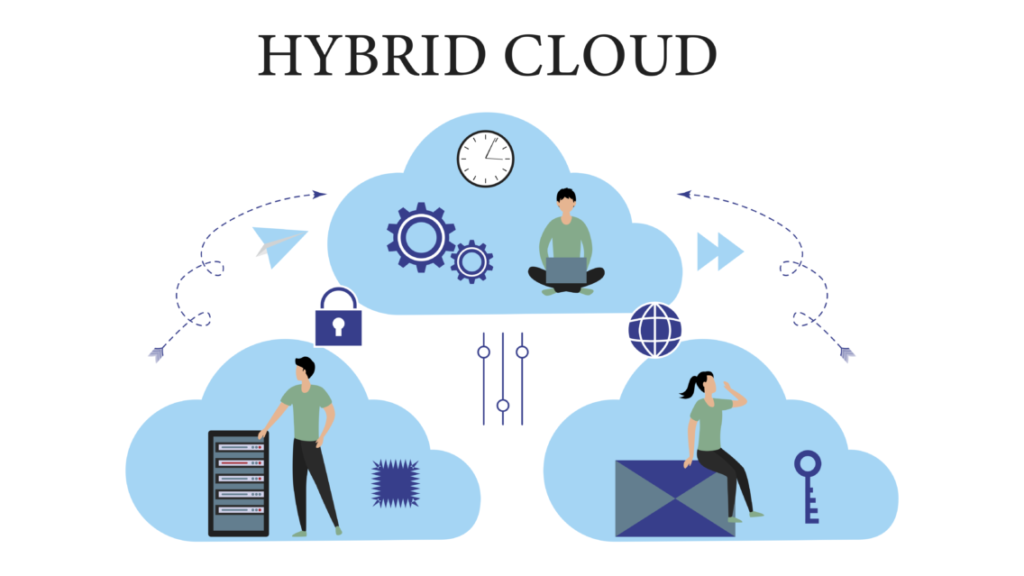
The recent Gartner studies predict that 90% of organizations will adopt a hybrid cloud approach through 2027.
As companies grow, evolve, and respond to shifting market dynamics, they’re recognizing a key truth: the cloud isn’t a single destination—it’s a spectrum. Choosing the right mix is no longer driven by hype, but by deliberate, strategic decisions. This is where hybrid cloud emerges—not just as a deployment model, but as a holistic approach. It seamlessly blends the agility and scalability of public cloud with the control, security, and compliance of private infrastructure—offering the best of both worlds.
We take a deeper look at what is hybrid cloud computing,
What Hybrid Cloud Really Means (And Why Definitions Matter)
At a high level, hybrid cloud in cloud computing refers to a computing environment that uses a mix of on-premises infrastructure (or private cloud) and public cloud services. But the definition isn’t just technical. In practice, it’s about creating a connected, flexible IT environment where workloads can move freely between different platforms, depending on performance, cost, security, or compliance needs.
Why Hybrid Cloud Is Becoming the Default Strategy
Enterprise hybrid cloud offers a pragmatic, scalable solution. Here’s why it’s catching on so widely:
Markets move quickly. Customer expectations change. Internal teams need room to experiment, deploy, and iterate. With a hybrid cloud strategy, organizations can spin up resources on the public cloud for rapid development or testing while keeping core systems stable and protected in a private or on-prem environment. This flexibility makes it easier to respond to new opportunities without rearchitecting everything.
Cloud costs can be unpredictable, especially when teams aren’t closely tracking usage. A hybrid setup allows you to balance cost and performance by keeping steady, long-running workloads in-house or on a private cloud while shifting bursty or seasonal demand to the public cloud when needed. It also helps reduce overprovisioning and avoids paying for unused capacity, something that was common in traditional IT environments.
Security and compliance are critical for industries like healthcare, banking, insurance, and government. For these organizations, keeping certain data or services within controlled environments is a must. Hybrid cloud security solutions enable that level of control while still offering access to modern capabilities like AI, machine learning, and advanced analytics through public cloud integrations.
Disruptions happen—outages, cyberattacks, natural disasters. Hybrid cloud storage solutions make it easier to build redundancy into systems. If one environment fails, workloads can be shifted to another without bringing operations to a halt. Many companies now use hybrid cloud applications as the foundation for their disaster recovery and high availability strategies.
The Challenges of Going Hybrid
Hybrid cloud computing for small business and large enterprises alike is powerful but not plug-and-play. It comes with a unique set of challenges:
Making private and public environments work together isn’t always straightforward, especially when legacy systems are involved. You’ll need to plan for compatibility, data synchronization, and application dependencies.
When workloads span environments, monitoring them gets trickier. Without proper tooling, it’s easy to lose track of where data is, who can access it, and how securely it’s being handled.
Hybrid environments require IT teams to be fluent in multiple platforms, tools, and practic
Before committing to a hybrid cloud strategy, consider the following:
What’s Next: Trends Shaping Hybrid Cloud in 2025
. Here are some of the most impactful trends shaping this space in 2025:
So, what is the major takeaway here? It’s that hybrid clouds are far from static. It is actively reshaping itself to meet the demands of a more complex, decentralized, and tightly regulated world. As business models evolve and new technologies emerge, hybrid cloud tech provides the adaptive infrastructure organizations need to stay resilient, scalable, and competitive.
Conclusion
The insights above make one thing clear: hybrid cloud is not a compromise—it’s a strategic choice. It enables organizations to build infrastructure that aligns with business needs—secure when it must be, scalable when it matters most, and cost-efficient where it counts. While the journey toward hybrid cloud can be complex, the benefits are compelling: enhanced performance, increased agility, improved resilience, and a future-ready foundation. Whether you’re working with legacy systems, striving to balance innovation with security, or simply seeking a smarter, more flexible approach to IT, hybrid cloud isn’t just an option—it could be the solution.
NetDataSec is the destination for enterprise tech leaders who need to stay ahead of change. We bring together the best minds in IT and business to explore trends, innovations, and strategies that drive digital transformation. Whether you’re navigating cloud migration, cybersecurity, AI, or emerging tech, NetDataSec delivers quick insights and deep dives to help you make smarter decisions, faster.
| Thank you for Signing Up |
